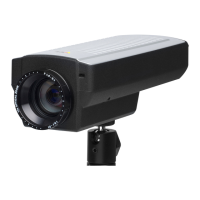44
AXIS Q1755/-E - System Options
SNMP
The Simple Network Management Protocol (SNMP) allows remote management of network devices. An SNMP community is
the group of devices and management station running SNMP. Community names are used to identify groups.
Depending on the level of security required, select the version of SNMP to use.
SNMP v1/v2
Select either SNMP v1 that includes no security, or SNMP v2c that uses very simple security.
The community name can be specified as a password for read or read/write access to all supported SNMP objects. The
community is the group of network devices using SNMP. The default password for the Read Community is public and the
default password for the Write community is write.
Traps for SNMP v1/v2
Traps are used by the camera to send messages to a management system for important events or status changes.
If Enable traps is selected, enter the email address where the trap message is to be sent as well as the Trap community that
should receive the message.
There are four types of traps available for AXIS Q1755/-E.
• Cold start
•Warm start
•Link up
• Authentication failed
SNMP v3
SNMP V3 - provides encryption and secure passwords. HTTPS must be enabled. To use traps with SNMP v3 an SNMP v3
management application is required.
If the Enable SNMP v3 option is enabled, provide the Initial user password. Note that the initial password is activated only
when HTTPS is enabled and can only be set once.
If HTTPS is enabled, SNMP v1 and SNMP v2c should be disabled.
When SNMP configuration is ready, click Save to use the new settings or Reset to return to the default values.
UPnP™
The network camera includes support for UPnP™. UPnP™ is enabled by default, and the network camera then is automatically
detected by operating systems and clients that support this protocol.
RTP/H.264
These settings are the port range, IP address, port number (video and audio), and Time-To-Live value to use for the video
stream(s) in multicast H.264 format. Only certain IP addresses and port numbers should be used for multicast streams. For
more information, please see the online help .
Bonjour
The network cameras include support for Bonjour. When enabled, the camera is automatically detected by operating systems
and clients that support this.
Storage - Disk Management
Disk Management is used to setup and manage local storage devices. Local storage can be used to save video streams from
triggered, scheduled or continuous recordings. For information on how to use the local storage with Triggered and Scheduled
Event Type Setup and Continuous Recordings see the online help
.

